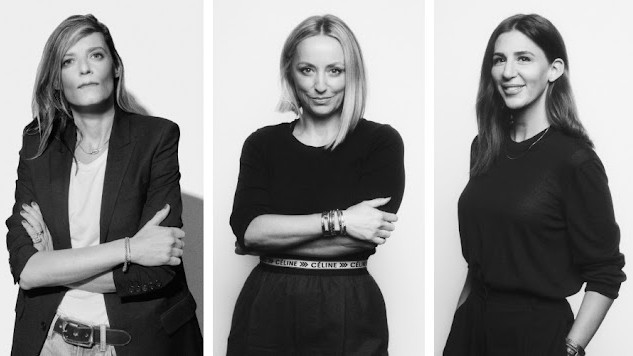Behind the Scenes of a Women-Led Acquisition
Ever wonder what goes on during an M&A deal? Here, Tradesy founder Tracy DiNunzio reveals what it's like to say goodbye to the company she built as it merges with Vestiaire Collective.


When the news of Vestaire Collective’s acquisition of Tradesy broke in March, the details surrounding how the deal came about and the future of Tradesy remained a bit hazy.
Until now.
This week, Tradesy merged its entire platform with Vestiaire Collective, bringing its 7 million U.S. members into Vestiaire Collective’s global platform. This gives Vestiaire, which already has a presence in Europe and the Asian-Pacific regions, a firm foot in the competitive resale landscape in the U.S. Like Tradesy, Paris-based Vestiaire Collective is a global luxury resale marketplace. It was launched in 2009 by six cofounders, including Fanny Moizant, who is currently president, and Sophie Hersan, who serves as fashion director.
Tracy DiNunzio also founded Tradesy in 2009. Weary of fast-fashion, the School of Visual arts graduate sold her car and some of her paintings to help fund the build-out of the online marketplace for gently used and timelessly chic luxury goods. According to Crunchbase, the company has raised more than $200 million in venture capital funding since 2012.
With this deal, DiNunzio is going from CEO of Tradesy, to U.S. CEO of Vestiaire Collective. Combined, the new company will boast a community of 23 million members, and a gross merchandise value (GMV) exceeding $1 billion.
When I first started Tradesy I didn’t think about how big to dream, I just wanted it to work. There were phases where I thought it could be as global as Uber or Airbnb.
Tracy DiNunzio
According to a Harvard Law study, "not only are women underrepresented as CEOs, but few leaders in the corporate development teams responsible for executing [merger and acquisition a.k.a.] M&A transactions are women." Recent high-profile acquisitions of female-founded companies (like Spanx, Knix, and BrioGeo) could be the start of a new wave of women-led deals. In this exclusive with Marie Claire, Dinunzio gives a candid behind-the-scenes look at the global deal featuring female cofounders on both sides of the signing table. She opens up about the acquisition and how she is readying herself to say goodbye to the company she’s built for 13 years, as Tradesy becomes Vestiaire Collective.

Marie Claire: Was a merger always your end goal when building your startup?
Get exclusive access to fashion and beauty trends, hot-off-the-press celebrity news, and more.
Tracy Dinunzio: Not at all. And I don’t think we would have done it with anybody but the team at Vestiaire Collective. When I first started Tradesy, I didn’t think about how big to dream; I just wanted it to work. There were phases where I thought it could be as global as Uber or Airbnb. Then the business landscape began to shift in favor of resale, and in the last two years, we kept asking ourselves, do we keep raising venture capital or do we start thinking about consolidating with another company in this category to form a bigger entity?
MC: Can you share any moments of contention or disagreement while finalizing this deal? How did both parties navigate the situation?
TD: Doing an M&A deal is like crafting the most complicated prenup ever. We had wonderful attorneys and bankers who represented both companies and helped us stay focused on the things that mattered. After you’ve figured out the basics, you have to sit together and imagine all of the things that could potentially go wrong and create agreements about how to handle them. It’s intense! But you’re entering into a partnership, and so it’s important to compromise, to discuss how you plan to handle conflict, and maintain a spirit of connection for the long-term value of the relationship. We were aligned on what we wanted to build and accomplish, which helped us to navigate some of the sticky parts, like agreeing on valuations and deal terms.
MC: M&As are sometimes categorized as cutthroat environments. How was this deal different?
TD: When we first thought about collaborating, we weren't thinking about M&As; it was more about how to accelerate the mission and the global fight to end fast fashion. It took five years before we settled on the current business deal and the structure of the team.
In a way, what Sophie, Fanny, and I are doing here is pioneering new ways of what it means to be in the same business category. How do we collaborate instead of compete? I believe competition comes from a scarcity mindset; the idea that there’s not enough. What we have is a more feminine type of leadership that rejects the idea of having to compete and cut each other down, and instead lift each other up to benefit our teams, investors, and customers.
MC: How is Vestiaire Collective impacting the way people shop and was this mission aligned with Tradesy’s?
TD: We had very similar business models, which made joining forces feel natural and authentic. Our customers buy and sell directly from each other, which reduces the shipping journey and hence, our carbon footprint. Vestiaire Collective made big strides in the industry last year by becoming the first B-Corp-certified luxury fashion resale platform.
Since then, we released an Impact Report with Price Waterhouse Cooper that found that purchasing secondhand fashion on the platform reduces the environmental impact of shopping by 90 percent.
MC: What is going on behind the scenes as both companies merge?
TD: Behind the scenes is a wild, fun, and hectic ride. We’re combining two teams into one, bringing together software engineers, fashion experts, and marketers from across the globe. Figuring out how to collaborate across cultures and time zones isn’t always easy, but thanks to the team’s hard work, we’re starting to run like a well-oiled machine.
We’re working to make it easy for buyers and sellers to move from Tradesy to Vestiaire Collective. Tradesy sellers will have their listings automatically moved onto the new resale platform in the next few months. Once they’ve moved over, they’ll enjoy access to more than 23 million buyers all over the world.
MC: What will happen to Tradesy once the merger is complete at the end of this year?
TD: It will take a few months to move all of our people and products over to Vestiaire Collective. When that’s done, we’re going to shut down the Tradesy app and website. Both will redirect to Vestiaire Collective.
MC: What it's like to say goodbye to the company you've built for 13 years?
TD: It’s emotional! In the few months since the acquisition, a lot of our team members have traveled to Vestiaire’s headquarters in Paris, and to our offices in New York, and most days it’s felt like a dream come true. We get to continue to pursue our collective mission and collaborate with new colleagues from all over the world.
There’s also a lot of processing and letting go, not just for me but for everyone who has been part of the Tradesy journey. The phase we’re in right now—moving customers to Vestiaire Collective—gives us a nice transition period for the team to say goodbye to the past and embrace the incredible future ahead.
MC: What words of advice do you have for female founders when it comes to navigating M&A deals or building a company that can one day be set up for acquisition?
TD: Never compromise your integrity to succeed. It takes a lot of hard work to steer a business through growth and an eventual sale, and that work can sometimes feel impossibly difficult and stressful—especially for female founders, who operate within a system that still contains so many obstacles.
But when you’re being thoughtful and acting in alignment with your values, you can speak freely and easily about your business in a way that attracts all kinds of interest. It readies you for the intense requirements and scrutiny that comes with any kind of “exit,” whether it’s a merger, acquisition, or IPO.
This interview has been edited and condensed for clarity.

Tanya Benedicto Klich is Senior Editor at Marie Claire where she manages the Money & Career section. Over the course of her 10+ years as a journalist she has overseen the coverage of female founders, funders, executives, innovators and more. Tanya was previously a Lifestyle Reporter for Forbes, where she worked at the ForbesWomen and Forbes Lifestyle verticals. She was also a Features Editor at Entrepreneur Magazine, and a former on-air reporter for NY1 News. Tanya is also a graduate of Columbia University Graduate School of Journalism where she specialized in business & economic journalism, and is an adjunct professor at the NYU Arthur L. Carter Journalism Institute. She lives in Brooklyn with her husband and two little sons. Follow her on Twitter: @TanyaKlich